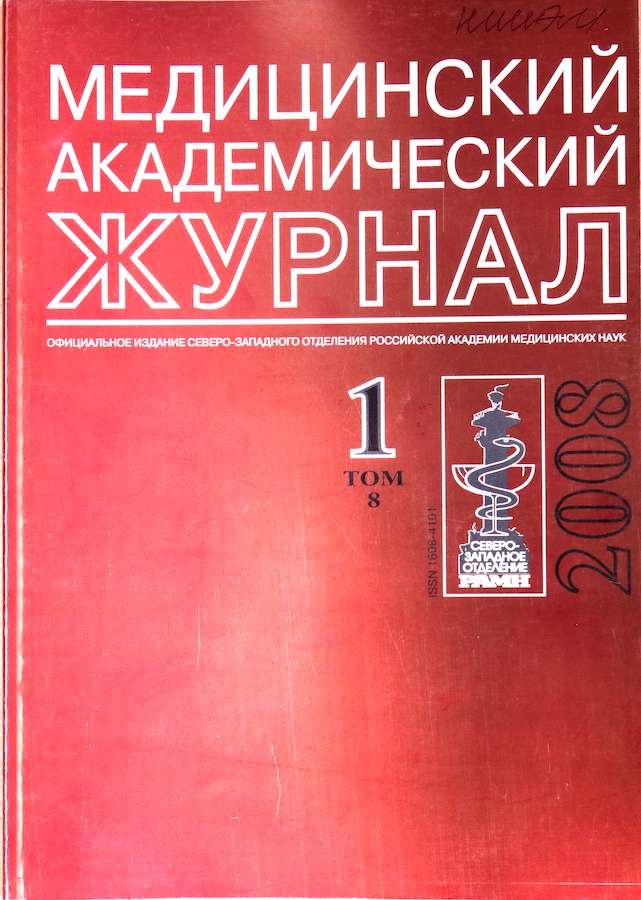Tetrapeptide effect on experimental diabetes mellitus
- Authors: Khavinson V.K.1, Malinin V.V.1
-
Affiliations:
- St. Petersburg Institute of Bioregulation and Gerontology of the North-Western Branch of the Russian Academy of Medical Sciences
- Issue: Vol 8, No 1 (2008)
- Pages: 145-151
- Section: Articles
- Published: 08.03.2008
- URL: https://journals.eco-vector.com/MAJ/article/view/693112
- ID: 693112
Cite item
Abstract
The analysis of amino acid sequences of insulinotropic polypeptides has revealed a common short segment, consisting of four amino acid residues. Tetrapeptide KEDWa, analogous to this segment and protected from the effects of amino acid proteinases, has been synthesized. Intramuscular administration of this tetrapeptide for 11 days to rats with alloxan diabetes partially restored the insulin synthesis. The degree of inclination of the sugar curve in this case was similar to that of healthy animals. Oral or intramuscular administration of the tetrapeptide for 10 days to rats with experimental streptosotocin diabetes showed, that orally administered tetrapeptide exerted a pronounced hypoglycaemic effect during its administration. Intramuscular administration normalized the adhesive ability of mesentery microvesseis endothelium, at the same time not affecting their permeability These results point out a hypoglycaemic and endothelioprotective effect of the tetrapeptide in case of experimental diabetes mellitus. It was suggested, that the tetrapeptide is an activator of promoter segment of preproinsulin gene, and that it complementarily interacts with nucleotide sequences ggcagg and cctgcc ofthe leading strand of the DNA double helix.
About the authors
V. K. Khavinson
St. Petersburg Institute of Bioregulation and Gerontology of the North-Western Branch of the Russian Academy of Medical Sciences
Author for correspondence.
Email: shabanov@mail.rcom.ru
член-корреспондент РАМН
Russian Federation, St. PetersburgV. V. Malinin
St. Petersburg Institute of Bioregulation and Gerontology of the North-Western Branch of the Russian Academy of Medical Sciences
Email: shabanov@mail.rcom.ru
Russian Federation, St. Petersburg
References
- Балаболкин М. И. Патогенез и механизм развития ангиопатий при сахарном диабете // Кардиология. 2000. № 10. С. 74-87.
- Варен К., Йоханссон Б.-Л., Йернвалль X. С-пептиды инсулина. Патент РФ № 99108434. 2001.
- Дюмаев К. М., Княжев В. А., Арчаков А. И. и др. Пептидный фрагмент, обладающий биологической активностью инсулина. Патент РФ № 2078769. 1997.
- Ефимов А. С. Диабетические ангиопатий. М.: Медицина, 1989. 287 с.
- Климов П. К. Пептиды и пищеварительная система. Л.: Наука, 1983. 372 с.
- Кахен А. Р., Елиас Д., Фридкин М. Аналоги пептида р277 и содержащие их фармацевтические композиции для лечения и диагностики диабета. Патент РФ №2159250 С2. 2000.
- Тутелъян В. А., Хавинсон В. X., Малинин В. В. Физиологическая роль коротких пептидов в питании // Бюл. эксперим. биол. и мед. 2003. Т. 135. № 1. С. 4-10.
- Хавинсон В. X., Малинин В. В., Григорьев Е. И., Рыжая Г. А. Тетрапептид, регулирующий уровень глюкозы при сахарном диабете, фармакологическое средство на его основе и способ его применения. Патент РФ № 2242241.2004.
- Хавинсон В. X., Шатаева Л. К, Бондарев И. Э. Модель взаимодействия регуляторных пептидов с двойной спиралью ДНК // Успехи соврем, биол. 2003. Т. 123. № 5. С. 467-474.
- Шатаева Л. К., Хавинсон В. X., Ряднова И. Ю. Пептидная саморегуляция живых систем (факты и гипотезы). СПб.: Наука, 2003. 222 с.
- Шатаева Л. К., Ряднова И. Ю., Хавинсон В. X. Исследование информационной ценности олигопептидных блоков в регуляторных пептидах и белках // Успехи соврем, биол. 2002. Т. 122. № 3. С. 282-289.
- Arikawa Е., Cheung С., Sekirov I. et al. Effects of en- dothelin receptor blockade on hypervasoreactivity in streptozotocin-diabetic rats: vessel-specific involvement of thromboxane A2 // Can. J. Physiol. Pharmacol. 2006. Vol. 84. № 8-9. P. 823-833.
- Ashcrof E M., Ashcroft S. J. H. Mechanism of insulin secretion / Insulin: Molecular Biology to Pathology. Oxford: IRL Press, 1992. P. 97-150.
- Babel J., Leuenberger P. A long term study on the ocular lesions in streptozotocin diabetic rats // Albrecht Von Graefes Arch. Klin. Exp. Ophthalmol. 1974. Vol. 189. № 3. P. 191-209.
- Fox C. J., Darby S. C., Ireland J. T., Sonksen P. H. Blood glucose control and glomerular capillary basement membrane thickening in experimental diabetes // Br. Med. J. 1977. Vol. 2. № 6087. P. 605-607.
- HarhaJ N. S., Felinski E. A., Wolpert E. B. et al. VEGF activation of protein kinase C stimulates occludin phosphorylation and contributes to endothelial permeability //Invest. Ophthalmol. Vis. Sci. 2006. Vol. 47. № 11. P. 5106-5115.
- Higashimoto Y., Liddle R A. Isolation and characterization of the gene encoding rat glucose-dependent insulinotropic peptide // Biochem. Biophys. Res. Com- mun. 1993. Vol. 193. № 1. P. 182-190.
- Ng Frank Man-Wbon, Jiang Woei-Ji. Insulin potentiating peptides. EP 1268518. 2001.
- RerupC., Tarding F. Streptozotocin- and alloxan-diabetes in mice // Eur. J. Pharmacol. 1969. Vol. 7. № 1. P. 89-96.
- Rodella L„ Lamon B. D„ Rezzani R. et al. Carbon monoxide and biliverdin prevent endothelial cell sloughing in rats with type I diabetes H Free Radic. Biol. Med. 2006. Vol. 40. № 12. P. 2198-2205.
- SewaldK., Jakubke H.-D. Peptides: Chemistry and Biology. WILEY-VCH Verlag GmH. Wemheim, 2002. 562 p.
- Tseng С. C„ Jarboe L. A., Landau S. B. et al. Glucosedependent insulinotropic peptide: structure of the precursor and tissue-specific expression in rat // J. Proc. Natl. Acad. Sci. U.S.A. 1993. Vol. 90. № 5. P. 1992-1996.
- Ullrich A., Dull T. J., Gray A. et al. Genetic variation in the human insulin gene // Science. 1980. Vol. 209. №4456. P. 612-615.
- Wehner H., Majorek B. Early glomerular changes in streptozotocin diabetes of the guinea pig // Virchows Arch. 1975. Vol. 368. № 3. P. 179-189.
Supplementary files






